Keeping The Spirit Alive: A Chat With The Team Behind Jerry Garcia Archival Releases
By Chad Berndtson Mar 15, 2017 • 1:10 pm PDT

Words by: Chad Berndtson
Even by the already-high standards of the four-year-old Garcia Live, Vol. 8 in the series — recorded during a November 8, 1991 Jerry Garcia Band show at the Bradley Center in Milwaukee — is a glorious listen: crispy and bountiful.
It features what’s perhaps the best-known version of the Jerry Garcia Band — Garcia, Melvin Seals, John Kahn, David Kemper, Gloria Jones and Jackie LaBranch — in an especially giving mood, lending credence to Seals’ assertion that this lineup was “the magic band” when it came to Garcia solo band performances.

In honor of Vol. 8’s release this month — the first in what’s promised to be a full year of Jerry Garcia archival releases in the year of what would have been the artist’s 75th birthday — we caught up with Marc Allan and Kevin Monty, artist managers at Red Light Management, and for some years now, working closely with the Garcia Family on releases from the Jerry vaults.
JAMBASE: So how does this process go? What goes into selecting volumes of Garcia Live?
MARC ALLAN: It’s morphed over time since we started to work with the Garcia family a few years ago. When we got onboard, it had been a couple of years and things had gotten quiet on the release front. We are fans first, so it was a dream come true when the vault showed up and we could start seeing what was in there and what might be available. I spent the first three months just listening to everything I could listen to. We worked with Joe Gastwirt on the earlier selections, and then it was I think Vol. 6 where Fred came aboard, Kevin?
KEVIN MONTY: Yes, Vol. 6 was Fred’s first project.
MA: Right, right, so we started working with Fred Kevorkian. We used the same process from the beginning of the series which is to target a time period — an era of the Jerry bands — and look at what’s there and what we might be able to do. We try and spread it around so it’s not all looking at one era or another. The Melvin/Jackie/Gloria era of the band was the longest running one, so of course there’s a lot more to choose from. We also like to balance those releases with Merl [Saunders] releases. In fact, right now we’re looking at our next Merl release. That kind of started from an e-mail from Justin Kreutzmann, who said, “Hey, have you guys put out anything with Jerry, Merl and Billy on it?” So we’re playing around with the concept of what we can do with that, and that’s probably going to be Vol. 9.
KM: It’s a lot about the feel and timing of something.
MA: Yeah, and I have to tip my hat to Kevin on Vol. 8, because he had that show marked for a while. He kept saying, you need to listen to this show. One day we both popped it on, and even just from what you can hear in the crowd reaction, you could tell it had one of those sparks.
JAMBASE: Is it often you know that right away? You can just tell from the get-go?
MA: They’re not all like that. Sometimes we have a release targeted, and it turns out, when I’m listening to the show I’ll chuck it over to Kevin and say this is phenomenal listen to this version of whatever, and then Kevin will be like, yeah, it sounds great, but listen to the end, there’s a really bad cut. There are definitely times where we have goosebumps right away, and just because we don’t get goosebumps doesn’t mean the show isn’t great or can’t rise to that level, we just got lucky with Vol. 8.
JAMBASE: Is most of what the Jerry bands played available to listen to?
KM: There are a few holes in the vaults, and we’re always looking for things. That said, it’s less so in the modern era. Once we get to 1987, and there was a DAT machine out there all the time, you get pretty much everything that Jerry and the band played publicly.
MA: As I’m sure you’re familiar with, though, the Jerry band had a different policy than the Dead did with regard to taping. It was not that same taper’s paradise. It was done a lot more with Garcia’s resources, so there’s not as much out there in the same way the Dead stuff is.
JAMBASE: Are there any underrated or under-observed eras from the Jerry band?
MA: I don’t know that they’re under-observed. You’re talking about an artist that’s been analyzed more and recorded as much as any other artist out there. You’ll find analysis on anything related to Jerry, and it’s one of the great things about Jerry Garcia, there’s always going to be that discussion. We’ll go out and look at a show, and find out based on some research that it’s a super-well-circulated show, and that may or may not play a role in whether we decide to release it. I mean, Milwaukee was well-circulated, but it’s just too good a listen, and the mastering that went into it makes it sound better than anything out there.
JAMBASE: Do you spend a lot of time speaking with the people who played with Jerry who are still around?
MA: We definitely speak to particular people. We’ve been working on the Symphonic tours with the family for example, and Melvin came out for one of those, and Jackie was on it for the whole tour. We try to stay in touch when they want to stay in touch. I know Kevin’s had a number of exchanges with Ron Tutt.
KM: It’s been great. He, they…everyone is supportive of these releases. Donna Jean [Godcheaux-Mackay], for example, located the tapes that became Vol. 7. She was really great to work with helping us find those and answer some questions. A lot of folks I know have been helpful in speaking with our liner notes authors, shedding light on their time with Jerry.
MA: I have to say though [laughing], we’re still stuck on the Vol. 6 trumpet player.
[Writer’s note: Garcia Live Vol. 6, which chronicles a Garcia and Saunders show from July 1973 in San Anselmo, CA, includes a sit-in from a trumpet player whose identity to this day remains unknown.]
I don’t know if there was a moment we spent more time on in terms of discovery. We can’t find out. And it’s not just us. I don’t know how many people we talked to who not only knew that show but who were at that show. Merl Jr. was there, he remembers the time, and he felt like it would have been a player who had played with his dad at that time, but no one he’s in touch with is willing to say “it’s me.” That’s our missing trumpet player. Hey man, if you’re out there, please give us a call! [laughs]
JAMBASE: Are you sticking to a set cadence of Garcia releases?
MA: We are trying to. Post-50th anniversary, we’re kind of making sure we get out one per quarter. Our bigger goal, of course, is also to be mindful of everything Rhino and the Dead camp are doing with their releases. We try to make it as symbiotic as possible. They are aware of us and what we’re trying to do, and they’re a great team to work with. We have to be aware of major events like you know, of course, that Cornell ’77 is coming. The heads, we all love them. As long as they keep showing this desire, we have a lot of music to share with people and a lot of ideas to keep this going. There are some things we want to do that will take a little more time, so we’re targeting no less than four physical releases plus one vinyl release every year.
JAMBASE: I’m guessing you get a lot of input from fans, solicited or not?
KM: We get suggestions all the time. We publish the e-mail address, so we get folks reaching out that way and through Facebook. I also get a lot of feedback from friends who steer me toward certain areas — Vol. 6 actually came from one of our colleagues who a while back mentioned it was one of his favorite Garcia shows. We always have our ears open. There are always new angles to explore.
JAMBASE: Be honest, how often do you guys second guess yourselves on the selections you’re making?
KM: We do second guess. Sometimes there are great shows that have some warts on them that guys like Joe and Fred have helped massage and smooth out. There are little gremlins in there that you just come to expect from a lot of listening.
JAMBASE: How do you gauge what’s tolerable to include? I have to think there are some really hot shows that you can’t release because they just sound like shit.
MA: You can always find a way to get something out. There was a brief time when Jerry was playing with a keyboard player named Jimmy Warren who has quite a backstory of his own. When I popped in some of that era early on, it was during a time when we were trying to create a database of what was well circulated and what was not well circulated. We quickly learned that it wasn’t really possible to get full versions of these shows out because of how what we have sounded. I remember a show from 1978 that had a smoking “Deal,” and an “After Midnight” where Jerry was just ripping it – it was the most fiery Garcia show I can think of. I took it to an engineer and he was like, um, no, given the it was a cassette master with all these flaws. We didn’t put it out, but we ended up offering the “Deal” as a free download. Something had to be heard from it.
KM: We’ve definitely had some jam-ups, but mostly for us it’s the completeness of the recording. Recordings from the 70s have some pretty gnarly cuts, and there are times where you’re really digging something and then the tape just runs out. The “Fall 1989: The Long Island Sound” release [from 2013], the first song on the first CD has Jerry’s vocal overloaded. It was an overdriven vocal mic. That was a hard decision because it’s the first song, but we made a collective decision that the rest of the show was too good to let the first 15 seconds spoil it.
But there are some cases where we’d make the opposite decision. There’s one show that both Marc and I really like that unfortunately has 15 seconds missing from the head of the tape because they hadn’t started the deck yet, and there doesn’t seem to be an audience recording out there to slide in to make up for it. If you’re putting this out commercially, you have to think about what’s fair to your listener. But the fans are polarizing. We get everything from “I’m so happy you did that” to “no one can live with that, why did you do this?” It’s an honor to just get to be doing it.
